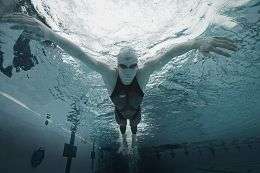Olympic Swimmers Shattering Records in NASA-Tested Suit

(PhysOrg.com) -- Swimmers from around the world are setting world and Olympic records in Beijing this month and most are doing it wearing a swimsuit made of fabric tested at NASA.
Among the Olympic gold medalists wearing Speedo's LZR Racer are Americans Michael Phelps -- who has now won more Olympic gold medals than any athlete in the modern era -- and Natalie Coughlin.
Both had a hand in developing the skintight body suit.
So did aerospace engineer Steve Wilkinson from NASA's Langley Research Center in Hampton, Va.
Wilkinson, who says he's not much of a swimmer himself, is watching this summer's Olympics with enthusiasm.
"I'm paying very close attention to the swimmers' times," said Wilkinson. "I'm amazed that so many athletes are wearing a fabric I tested in a laboratory in Hampton, Virginia."
Researcher Wilkinson has tested dozens of swimsuit fabrics in NASA Langley's 7- by 11-Inch Low Speed Wind Tunnel.
"This is a fundamental research facility," said Wilkinson. "What we look at are concepts for reducing drag on otherwise smooth surfaces. This is more directed toward fundamental physics … the interactions between the flow AND THE SURFACE."
The fabric that made it through Wilkinson's wind tunnel analysis has already caused a big splash since the LZR Racer swimsuit was introduced in February. Even before the Olympics swimmers wearing the skin-tight body suit set 48 world records.
But how did NASA get involved in what is probably the most talked-about swimsuit since the bikini? Warnaco Inc., the U.S. licensee of the Speedo swimwear brand, approached NASA Langley to test fabric samples, since NASA Langley has researched drag reduction for aircraft and even boats for decades.
"We evaluated the surface roughness effects of nearly 60 fabrics or patterns in one of our small low speed wind tunnels," said Wilkinson. "We were assessing which fabrics and weaves had the lowest drag. The tests have generally shown the smoother the fabric, the lower the drag."
Just like reducing drag helps planes fly more efficiently, reducing drag helps swimmers go faster. Studies indicate viscous drag or skin friction is almost one-third of the total restraining force on a swimmer. Wind tunnel tests measure the drag on the surface of the fabrics.
"The fabric comes in the form of fabric tubes, a small diameter fabric tube," Wilkinson added. "We pull that over our smooth flat model, which is an aluminum plate underneath. We prepare the edges so they're straight and square with no protruding corners or edges to interfere with the drag on the surface."
The plate goes into the small wind tunnel test section. With a flip of a switch, air flows over it. Wilkinson runs the tunnel through a number of wind speeds and, with the help of sensors, measures drag on the surface. He records the data and then sends it on to Speedo researchers.
Speedo's research and development team, Aqualab, takes the results and uses them to help create advanced "space-age" swimsuit designs.
Wilkinson says he never expected that he would test swimsuit fabric when he started at NASA 30 years ago. He adds he gets a lot of chuckles from his colleagues. As he's watching the Olympics, knowing that he played a small part in swimming history, Wilkinson may be having the last laugh.
Provided by NASA Langley Research Center




















